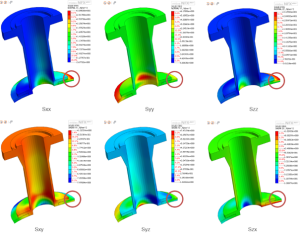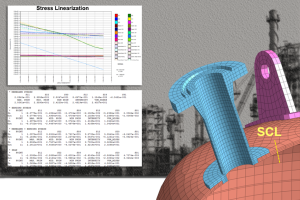Let’s suppose that someone in a bar asks you what is stress linearization, how would you answer?
(The bar just next MIT…)
I would answer like that:
“When you apply a pressure on a solid and this solid becomes stressed, stress created has 6 components in each point of the solid. It’s cool because your stresses are totally defined in all directions, but this is not the way the guys who wrote the ASME code wanted it to be”

Why is that?
“Because in the code, stresses are separated in 3 classes that are associated with different types of failure:
Primary stress is associated with gross plastic deformation.
Secondary stress (plus primary stress) is associated with incremental plastic collapse.
Peak stress (plus primary, plus secondary) is associated with fatigue failure
Each “type” of stresses is limited to different allowable values specified in terms of a design stress”
How do I determine those 3 classes of stresses from the six stress components I get from my FEA analysis?
“Stress linearization of course!”

So stress linearization is a way to convert the six stress components into those primary, secondary, and peak stresses?
“Yes, it is, now you got it”
But how does it really work and how can it transform those 6 components into primary, secondary and peak stress?
“I cannot tell you everything, sometimes, you just have to open a book and learn by yourself!” (Translation: Actually, I don’t know but if you find it in the book, let me know…)
“But remember, there are also limitations to stress linearization due to elastic analysis! The Major problem is the stress categorization because stress distribution must always be defined in terms of membrane, bending, and peak stress.”
“Moreover, stress cannot always be linearized everywhere in a vessel… but in practice designers don’t really care and regard linearization as valid throughout the vessel for both 2D and 3D models.”
Want to know more about stress linearization?
Here’s another article about the topic:
Dear Cyprien,
Recently got an opportunity to go through the article on your site. This seems to be very interesting explaining in the moat simpler way. I have a doubt regarding Stress linearisation any sort of reply could help me in handy. I’m designing a saddle for pipe using Ansys and qualifying according to ASME sec VIII whch requires stress linearisation. Now how do we choose the Stress critical line to linearise stress. If suppose I use Shell element can i get the Membrane + Bending In equivalent Von misses (Choosing Top/Bottom).
If suppose i use solid elements how do i choose the SCL for linearising stresses Will it be the line passing through the max Von misses stress
Best Regards,
Vignesh kumar V
Not every time.But you should have to put SCLs at all critical locations like across pipe thickness at junction with saddle wear plate etc…
ASME BPVC Section VIII, Div 2, ANNEX 5-A.
This is a good place to learn, but if you have access to this document, you probably already have an appreciation of stress linearization.
Cheers,
Paul.
How to verify our results ,what would be the allowable peak stress
That depends on your model and what you decide Bahnudas. Check this article on the safety factor, this will probably help you: http://feaforall.com/category/open-source-fea/